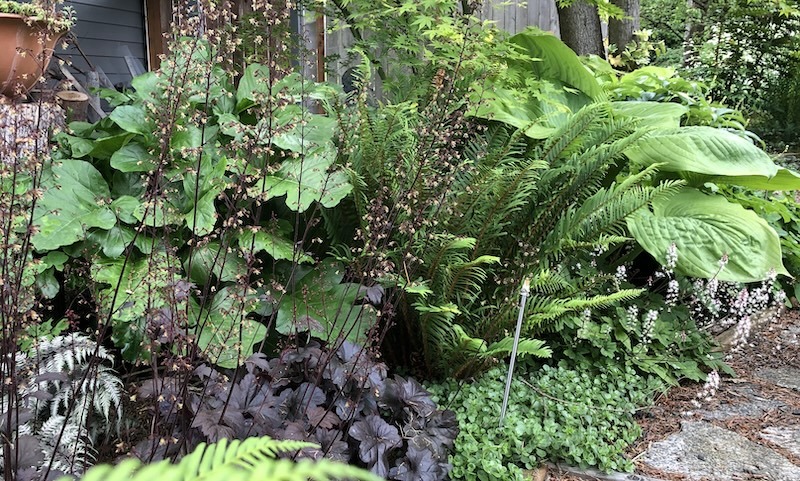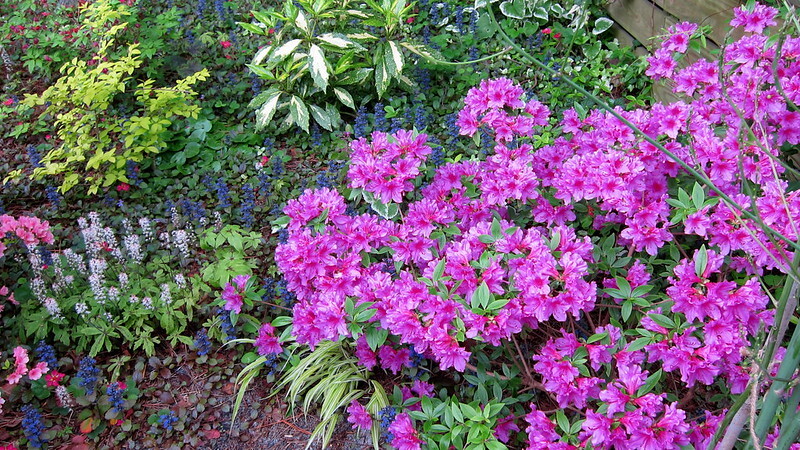Foamflowers give a woodland or partially shaded garden depth and texture. The soft spikes of creamy-colored flowers appear for weeks from late spring to early summer while the foliage stays fresh and full through the fall. Winter hardy for USDA growing zones 3-8, foamflower spreads moderately by underground rhizomes and is easy to control when mixed with other groundcovers.

Foamflowers can tolerate short periods of drought when fully established, but require soil that is both well-draining and moisture-retentive for vigorous growth. This North American native grows best in soil with a neutral or acidic pH and appreciates an application of organic compost in the spring. The only regular maintenance required is deadheading the spent flower spikes in late spring to tidy up the plants and allow for good foliage growth.
Shrubs To Plant With Foamflower
Plant foamflower at the base of broadleaf evergreens like azalea, rhododendron, mountain laurel, nandina, daphne, camelia, and pieris for a fresh spring display of flowers and foliage. Other shrubs that thrive in shaded conditions with well-draining soil are hydrangeas, snowberry, mock orange, dogwoods, viburnum, and witch hazel. These natives look wonderful with an underplanting of foamflower either mixed with other perennials or planted en masse as a groundcover.

Photo by K M, unmodified, Flickr, copyright CC BY 2.0 DEED
Perennials To Plant With Foamflower
Foamflower is not an aggressive perennial but clumps will slowly expand each year. It works best as a ground cover near other shade-loving perennials, such as hosta, ferns, hellebores, Japanese anemone, hardy geranium, woodsorrel, and lungwort. These perennials provide contrasting leaf forms even when flowering has finished for the summer. They also share the same requirements of consistently moist soil and part to dense shade for an easy-to-care-for display.
Underplanting woodland areas with spring bulbs results in a colorful, but naturalistic look. Foamflower pairs easily with spring bulbs including crocus, daffodils, snakehead fritillaria, and camas lilies. The bulbs take advantage of the brighter sun exposure before the taller shrubs and trees leaf out later in spring. The bulbs will spread slowly without upsetting any later appearing perennials in the garden.

Photo by K M, unmodified, Flickr, copyright CC BY 2.0 DEED
Annuals To Plant With Foamflower
Annuals that grow well in shade make great companions for foamflowers in a garden border. Interplant bedding plants such as impatiens, wax begonias, sweet alyssum, lobelia, or floss flower with foamflower to give the bed a dense mix of color for months. Taller annuals like nicotiana, browallia, monkey flowers, fuchsia, and coleus can add contrast and depth. Choose plants to highlight the foamflower's leaf patterns and texture after the early spring perennials have gone dormant.
Best Companion Plants For Foamflower in Containers
Foamflowers work well in a mixed seasonal planter as a filler plant. The short period of flowering in the early summer adds to the overall interest, but the leaf patterns and colors of foamflower are the real focus. Combine a thriller like purple fountain grass with shade-loving filler and spiller plants like foamflowers, hostas, ferns, coral bells, and ornamental kale. The combination makes a long-lasting display that will continue in the fall despite a light frost or two.
Potted foamflower requires regular watering even in a shaded spot. Only allow the top 1- 2 inches of potting mix to dry before watering. A light fertilization every 3-4 weeks with a diluted liquid formulation helps to maintain strong growth and vibrant color. Use a feed with a balanced NPK ratio to support both foliage plants and flowering annuals growing in the same container.
Plants Not To Grow With Foamflower
Foamflower is not suited to growing in full sun with meadow flowers like yarrow, coneflower, black-eyed Susan, and ox-eye daisy. Drought-tolerant prairie grasses that spread aggressively are also not a great choice to grow alongside the more delicate and slower-growing foamflower. Plants that need boggy or submerged soil will not survive even one season growing in the relatively dry, shaded soils of a woodland garden with foamflowers.
Best Plants To Grow With Foamflower
Foamflower pairs best with other native species and woodland plants in a home garden. Look for interesting foliage partners like ferns, wild ginger, and bleeding hearts, along with regional native shrubs like snowberry, mock orange, and flowering currant. These plants will grow well in a partially shaded location, resulting in a low-maintenance garden bed that both provides ornamental and wildlife value.
Sources: “Foamflower (Tiarella cordifolia).” Georgia Native Plant Society. gnps.org
